SOCIAL WORK
Paper – III
Note : This paper contains seventy five (75) objective type questions of two (2) marks each. All questions are compulsory.
1. The right to choose the place of meeting in social case work is preferably vested with the
(1) Agency
(2) Client
(3) Social Worker
(4) Person accompanying the client
2. What is the number of proposed targets for Sustainable Development Goals (SDGS) adopted by UN General Assembly on 25 September, 2015 ?
(1) 170
(2) 165
(3) 169
(4) 155
3. In the year 1915, the controversial speech titled, ‘Is social work a profession’ at the National Conference on charities and corrections was delivered by :
(1) Mary Richmond
(2) Gisela Konopka
(3) Abraham Flexner
(4) Herbert Bisno
4. “Make in India” campaign is primarily intended to
(i) Attract global investment
(ii) Provide job opportunities
(iii) Boost economy
(iv) Organize innovative programmes
Codes :
(1) (ii) and (iv) only
(2) (i), (iii) and (iv) only
(3) (iii) and (iv) only
(4) (i), (ii) and (iii) only
5. Feeling of extreme sadness and loneliness is symptom of
(1) Phobia
(2) Hysteria
(3) Manic depression
(4) Paranoia
6. Abnormal psychology is presently called
(a) Psycho pathology
(b) Study of abnormal behaviour
(c) Science of mental disorders
(d) Science of neurotic disorders
Codes :
(1) (a) only
(2) (a) and (b) only
(3) (a), (b) and (c) only
(4) (a), (b), (c) and (d)
7. Which one of the following skills of social group work was not given by H.B. Trecker ?
(1) Skill in using reality of the present
(2) Skill in establishing purposeful relationship
(3) Skill in analysing group situation
(4) Skill in participation with the group
8. Institutional Redistribution Model of social policy is associated with
(1) Welfare state
(2) Capital state
(3) Communist state
(4) Police state
9. Which act requires employers in industrial establishments to define the conditions of employment ?
(1) The Factories Act, 1948
(2) The Industrial Dispute Act, 1947
(3) The Industrial Employment (Standing orders) Act, 1946
(4) The Trade Union Act, 1926
10. As per global definition of 2014, social work is not concerned with the promotion of which one of the following ?
(1) Social change
(2) Social cohesion
(3) Social choices
(4) Liberation of people
11. Which of the following is not a system in system approach ?
(1) Change agent system
(2) Client system
(3) Target system
(4) Personality system
12. Drug abuse denotes
(1) Frequent use of drug
(2) Use of illicit drug
(3) Physical dependence on drug
(4) Psychological dependence on drug
13. Which among the following is not a feature of Random Sampling ?
(1) It makes the sample representative of the population.
(2) It ensures generalization of results.
(3) It reduces error and increases precision of the experiment.
(4) It maximizes experiment variances.
14. The confirmatory test used to diagnose HIV is
(1) ELISA
(2) Western Blot
(3) ESR test
(4) PCR test
15. Juvenile Justice Board deals with the issues of
(1) Children in need of care and protection
(2) Children in conflict with law
(3) Missing children
(4) Special children
16. A short term or temporary care for a few hours or weeks designed for the sick or disabled to provide relief to the regular care giver is called
(1) Institutional care
(2) Respite care
(3) Advance care
(4) Revival care
17. Terms of Reference (TOR) includes
(i) Time dimension
(ii) Expected Results
(iii) Corrections
(iv) Limitations
Codes :
(1) (ii) only
(2) (ii) and (iii) only
(3) (i) and (iv) only
(4) (i), (ii) and (iv) only
18. Who among the following is associated with the concept of ‘Social Fact’ ?
(1) Emile Durkheim
(2) Karl Marx
(3) M. Mauss
(4) Max Weber
19. Herbert Spencer’s model of society was essentially
(1) Consensus
(2) Organic
(3) Functionalist
(4) Conflict
20. The use of Random tables for drawing a sample is also called as
(1) Simple random sampling
(2) Quota sampling
(3) Lottery method
(4) Tippet’s method
21. ‘CARINGS’ is a term associated with
(1) Surrogacy
(2) Adoption
(3) Children’s Parliament/Bal Panchayat
(4) Interest groups
22. Sum of squares of deviation taken from Mean is always __________.
(1) Maximum
(2) Least
(3) Greater than Median
(4) Zero
23. Which of the following is not a HR function ?
(1) Ensuring barrier free access
(2) Promoting work culture
(3) Financial audit
(4) Training and development
24. Locality Development Model of community development was propounded by whom ?
(1) Saul David Alinsky
(2) Gordon Hamilton
(3) Jack Rothman
(4) M.G. Ross
25. Which among the following is/are characteristics of a good social planning process ?
(i) Participatory
(ii) Democratic
(iii) Inclusive
(iv) Centralised
Codes :
(1) (i), (ii) only
(2) (i), (ii), (iii) only
(3) (i), (ii), (iv) only
(4) (i), (ii), (iii), (iv)
26. Which among the following therapies is/are associated with behaviour modification ?
(i) Impulsive therapy
(ii) Assertive therapy
(iii) Aversion therapy
(iv) Simple extinction
Codes :
(1) (i) and (ii) only
(2) (ii) and (iii) only
(3) (i), (ii) and (iii) only
(4) (i), (ii), (iii) and (iv)
27. ‘Ashram Shala Yojana’ is the Central Government scheme to promote education among
(1) Other backward classes
(2) Scheduled castes
(3) Scheduled tribes
(4) Children of inter-state migrant workers
28. Asymmetrical distribution indicates
(1) Range
(2) Standard Deviation
(3) Skewness
(4) Kurtosis
29. Which among the following department was created under the Ministry of Social Justice and Empowerment in May 2012 ?
(1) Department of AYUSH
(2) Department of Disability Affairs
(3) Department of Youth Affairs
(4) Department of Refugee Rehabilitation
30. Social Distance Scale was developed by
(1) Likert
(2) Thorndike
(3) Bogardus
(4) Thurston
31. The points of scatter plots are randomly distributed among the quadrants, when little ________ exists between the variables.
(1) Difference
(2) Correlation
(3) Regression
(4) Association
32. Who is the Vice-Chairman of NITI Aayog ?
(1) Narendra Modi
(2) Bibek Debroy
(3) Arvind Panagariya
(4) Nitin Gadkari
33. Which one of the following is not a characteristic of collective bargaining ?
(1) It is a collective process.
(2) It is a flexible process.
(3) It is not a bipartite process.
(4) It is interdisciplinary system.
34. The acronym ‘NITI’ in NITI Aayog stands for
(1) National Institution for Transforming India
(2) National Institute for Transforming India
(3) National Intelligence Training Institute
(4) New India Training Institute
35. The term “Vicious Cycle” was proposed by
(1) Amartya Sen
(2) Gunnar Myrdal
(3) Andre Gunder Frank
(4) Emile Durkhiem
36. Who among the following is associated with Mazdoor Kisan Shakti Sangathan ?
(1) Arvind Kejriwal
(2) Anna Hazare
(3) Aruna Roy
(4) Arundhati Roy
37. Belief in the worth of the individual is related to _________.
(1) Social work values
(2) Social work techniques
(3) Social work principles
(4) Social work methods
38. Mobilizing resources is associated with __________.
(1) Advocacy Role
(2) Catalyst Role
(3) Broker Role
(4) Planner Role
39. Which among the following schemes is associated with the prevention of trafficking of women and children for commercial sex exploitation ?
(1) Ambedkar Hastshilp Vikas Yojana
(2) Swadhar Yojana
(3) Ujjawala Scheme
(4) Rastriya Swasthya Bima Yojana
40. Advocacy may not be essentially a part of which of the methods of social work ?
(1) Social Case Work
(2) Social Action
(3) Social Group Work
(4) Social Work Research
41. A social system is that _______.
i. has various parts
ii. is a whole
iii. has a boundary
iv. has sub-systems
Codes :
(1) i, ii, iii only
(2) i, ii, iv only
(3) i, iii, iv only
(4) i, ii, iii, iv
42. The concept of ‘Wholeness’ and ‘Here and now’ are related to which of the following :
(1) Functional School
(2) Gestalt Theory
(3) Life Model
(4) Crisis Theory
43. During which period, India’s population marked negative growth rate ?
(1) 1901-1911
(2) 1911-1921
(3) 1921-1931
(4) 1991-2001
44. The name of Shramik Vidyapith is :
(1) Labour Education Camp
(2) Jan Shikshan Sansthan
(3) Vanasthali Vidyapeeth
(4) Labour Literacy Board
45. ‘Something given or demanded as repayment for wrong doing’ refers to __________.
(1) Rehabilitation
(2) Correction
(3) Retribution
(4) Reformation
46. According to 2011 census, the literacy rate of India is
(1) 62 percent
(2) 74 percent
(3) 80 percent
(4) 82 percent
47. The main focus of “Atal Pension Yojana” (APY) is on
(1) Retired persons from Quasi-government sector
(2) Workers of unorganised sector
(3) Workers of organised sector
(4) Ex-servicemen
48. The name of the 2012 Delhi Rape Victim was coined by the media as “Nirbhaya”. Which principle of social case work does it relate to ?
(1) Non-Judgmental Attitude
(2) Individualization
(3) Acceptance
(4) Confidentiality
49. What is/are the purpose(s) of agencies involved in the field of corrections ?
(i) Reformation
(ii) Training
(iii) Education
(iv) Retribution
Codes :
(1) (i), (ii), (iii) only
(2) (i), (ii), (iv) only
(3) (i), (ii), (iii) and
(iv) (4) (i), (ii) only
50. Sansad Adarsh Gram Yojana is implemented by
(1) Members of Parliament
(2) Members of Legislative Assembly
(3) Department of Adult Education
(4) Village Panchayat
51. The PC PNDT Act primarily addresses to :
(1) Legal Abortion
(2) Sex selective abortion
(3) Abortion care to unwed mothers
(4) Abortion care to rape victims
52. According to the Mahatama Gandhi National Rural Employment Guarantee Act, the percentage of women beneficiaries shall be
(1) 50 percent
(2) 75 percent
(3) 33 percent
(4) 100 percent
53. Fear of elimination is a symptom of
(1) Paranoia
(2) Schizophrenia
(3) Hysteria
(4) Manic depression
54. Which of the sections of Indian Penal Code deals with cruelty to women by husband or relatives of husband ?
(1) Section 198 A
(2) Section 298 A
(3) Section 398 A
(4) Section 498 A
55. The periodical survey for estimating poverty line in India is conducted by :
(1) National Sample Survey Organization
(2) Indian Statistical Institute
(3) Operational Research Bureau
(4) NITI Aayog
56. Who introduced the concept ‘life space’ to explain the nature of relationship between person and environment ?
(1) Allport Gordon
(2) Kurl Lewin
(3) Michel Gordon
(4) Hamilton
57. The author of the book, ‘From charity to social work in England and United States’ is
(1) Kathleen Woodroofe
(2) Mary Wollestonecraft
(3) Mary Richmond
(4) Elizabeth Agnew
58. Arrange the major milestones of social work history in chronological order starting from the earliest to the latest :
(i) Elizabethan Poor Law
(ii) Charity Organization Society
(iii) Settlement House Movement
(iv) Medical social work
Codes :
(1) (i), (ii), (iii), (iv)
(2) (iv), (iii), (ii), (i)
(3) (ii), (i), (iii), (iv)
(4) (i), (iii), (ii), (iv)
59. Assertion (A) : A well drafted social policy is based on the voices of the people and connects with the grassroots.
Reason (R) : Social policies are framed in the areas of social concern.
Codes :
(1) Both (A) and (R) are incorrect.
(2) (A) is not correct, but (R) is correct.
(3) Both (A) and (R) are correct and (R) is the correct explanation of (A).
(4) (A) is correct, but (R) is incorrect.
60. Assertion (A) : Bal Panchayat or children’s parliament modelled on the concept of Gram Panchayat is an initiative of UNICEF.
Reason (R) : Participation of children on the issues which affect them or affect society at large is the thrust behind formation of Bal Panchayat.
Codes :
(1) Both (A) and (R) are correct.
(2) Both (A) and (R) are incorrect.
(3) (A) is correct, but (R) is incorrect.
(4) (A) is incorrect, but (R) is correct.
61. Assertion (A) : Street vendors are an indispensable part of the society.
Reason (R) : Street vendors belong to the unorganized sector of the economy and do not have any government assisted social security.
Codes :
(1) Both (A) and (R) are correct and (R) is the correct explanation of (A).
(2) Both (A) and (R) are not correct.
(3) Both (A) and (R) are correct and (R) is not the correct explanation of (A).
(4) (A) is correct but (R) is incorrect.
62. Match the List – I with List – II and choose the correct answer from the codes given below :

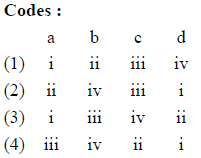
63. Match the List – I with List – II and choose the correct answer from the codes given below :

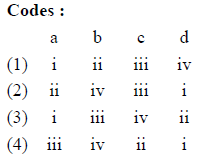
64. Match the List – I with List – II and select the correct answers from the codes given below :

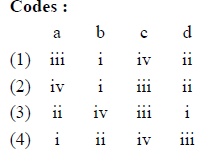
65. Match List – I with List – II and select correct answer from the codes given below :
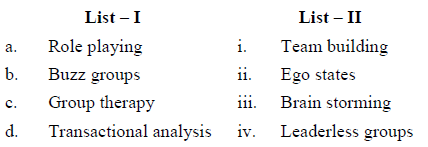
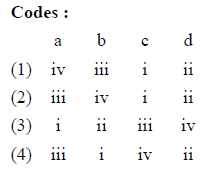
66. Match the List – I with List – II and select correct answer with the help of codes :

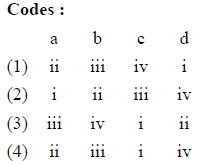
67. Assertion (A) : Even after 75 years since inception social work continues to struggle for its professional status in India.
Reason (R) : Principles of Human Rights and Social Justice are fundamental to social work profession.
Codes :
(1) Both (A) and (R) are correct.
(2) Both (A) and (R) are not correct.
(3) (A) is true, but (R) is false.
(4) (A) is false, but (R) is true.
68. Assertion (A) : Empowerment leads to development and self sufficiency.
Reason (R) : Many people in India are not empowered.
Codes :
(1) (A) and (R) are correct.
(2) (A) is correct and (R) is incorrect.
(3) Both (A) and (R) are incorrect.
(4) (A) is incorrect, but (R) is correct.
69. Arrange the following enactments related to environmental protection in chronological order from the codes given :
(a) The Water (Prevention and Control of Pollution) Act.
(b) The Air (Prevention and Control of Pollution) Act.
(c) The Wildlife (Protection) Act.
(d) The Forest (Conservation) Act.
Codes :
(1) (c), (a), (d), (b)
(2) (a), (b), (c), (d)
(3) (b), (c), (a), (d)
(4) (d), (c), (b), (a)
70. Arrange the following Central Government Schemes in chronological order with regard to their year of launch :
(a) National Social Assistance Scheme
(b) Deendayal Disabled Rehabilitation Scheme
(c) Pradhan Mantri Ujjwala Yojana
(d) Pradhan Mantri Kaushal Vikas Yojana
Codes :
(1) (c), (a), (b), (d)
(2) (b), (d), (c), (a)
(3) (a), (b), (d), (c)
(4) (a), (c), (b), (d)
Read the passage given below and answer the following questions (71-75) as per understanding of the passage :
The need for an alternative to conventional social work is more obvious today than ever before. Given its acceptance of our present social order and its emphasis on reform of the individual and limited social reform, conventional social work appears powerless to deal with the increasing social problems that have already overloaded a diminishing welfare state.
With the social discontent fomented in the 1960s, social workers were critiqued as being a part of the problem by choosing to emphasize casework as a model of practice, an approach that perpetuated the pathologizing of clients. Furthermore, social workers were viewed as helping clients to “accept and adapt to basically unjust social structures” with the profession being “nothing else but a professionally elitist activity that mystified, infantilized and disempowered clients”.
Structural social work reveals the shortcoming of welfare capitalism as a social system and shows how conventional social work has failed to respond to systemic social problems. The structural model demands that social workers “abandon their social control function to involve themselves in institutional and structural change”. Emphasis shifted to seeking more collaborative, dialogical relationships, rather than top-down, expert models with service users.
Structural social work is part of a critical, progressive tradition that has been concerned with the broad socio-economic and political dimensions of society, especially the effects of capitalism, and the impact of these influences in creating unequal relations amongst individuals. Its primary goals have been to reduce social inequality through the transformation of Western, Euro-Centric civilizations and the emancipation of those who have been oppressed. The lens of this theoretical approach has been focused on the interplay between the agency of individuals and structures, particularly the broad structural barriers which influence and limit the material circumstances of service users.
Structural social work theory begins from a conflict, rather than an order perspective. The theory regards society as composed of groups with conflicting interests who compete for resources, power, and the imposition of their own ideological views. In this perspective, social problems are more the result of “defective rules” which pathologize those who are marginalized and the consequence of institutional arrangements which maintain social hierarchies, rather than faulty socialization of individuals.
Structures refer to “social regularities and objective patterns external to individual action, intentions, and meanings, and not reducible to the sum of those meanings or actions”, specifically both institutional arrangements and broad social relational patterns such as racism and sexism.
71. Structural social work is a departure from the conventional social work in the sense that
(1) It demands social workers to get involved in institutional and structural change by abandoning their social control function.
(2) Emphasize on more collaborative and dialogical relationships.
(3) It denounces top-down expert models with service users.
(4) It shows how conventional social work has failed to respond to systemic problems.
72. The major concerns of structural social work are
(1) To focus on the interplay between agency of individuals and structures.
(2) To reduce social inequality by containing effects of capitalism.
(3) Emancipation of those who have been oppressed.
(4) Transformation of Western, Euro-centric civilizations
73. Structure social work views social problems as –
(1) Faulty socialization of individuals
(2) A consequence of individual arrangements
(3) A result of defective rules
(4) A manifestation of maintenance of social hierarchies
74. Structural social work theory conceptualizes structures as –
(1) Institutional arrangements and social relational patterns
(2) Individual action, intentions and meaning
(3) A sum of meanings or actions of an individual
(4) Social regularities and objective patterns in terms of institutional arrangements and relational patterns.
75. Why do we need an alternative to the conventional social work ?
(1) Conventional social work is powerless
(2) As social problems have increased with the diminishing welfare state
(3) As its emphasis is more on reform of the individual than present social order.
(4) Acceptance to present social order.
Latest Govt Job & Exam Updates: